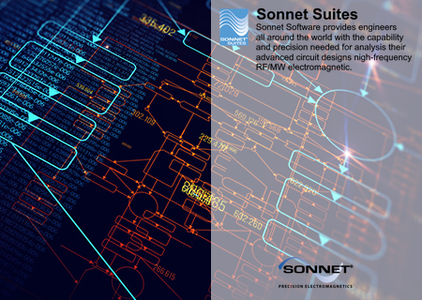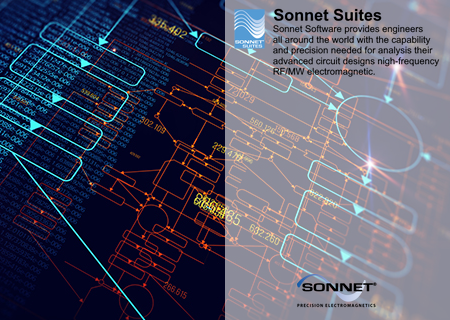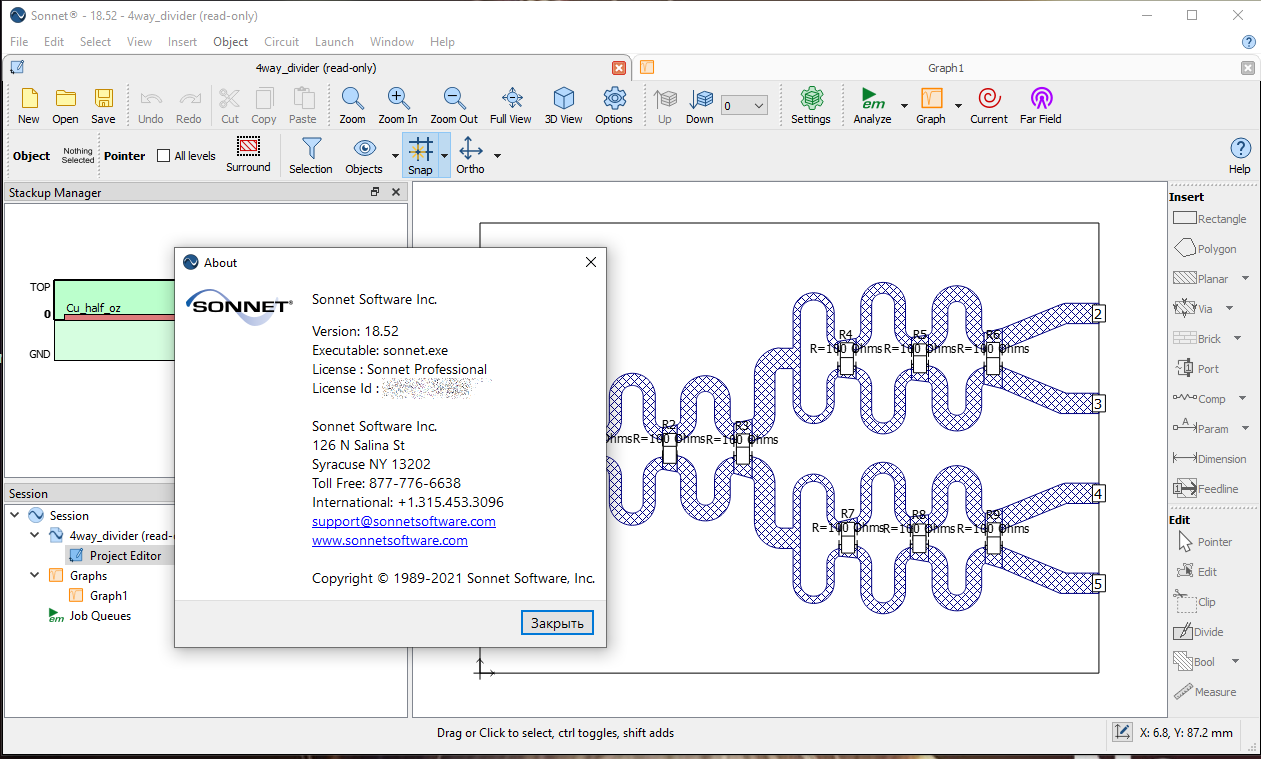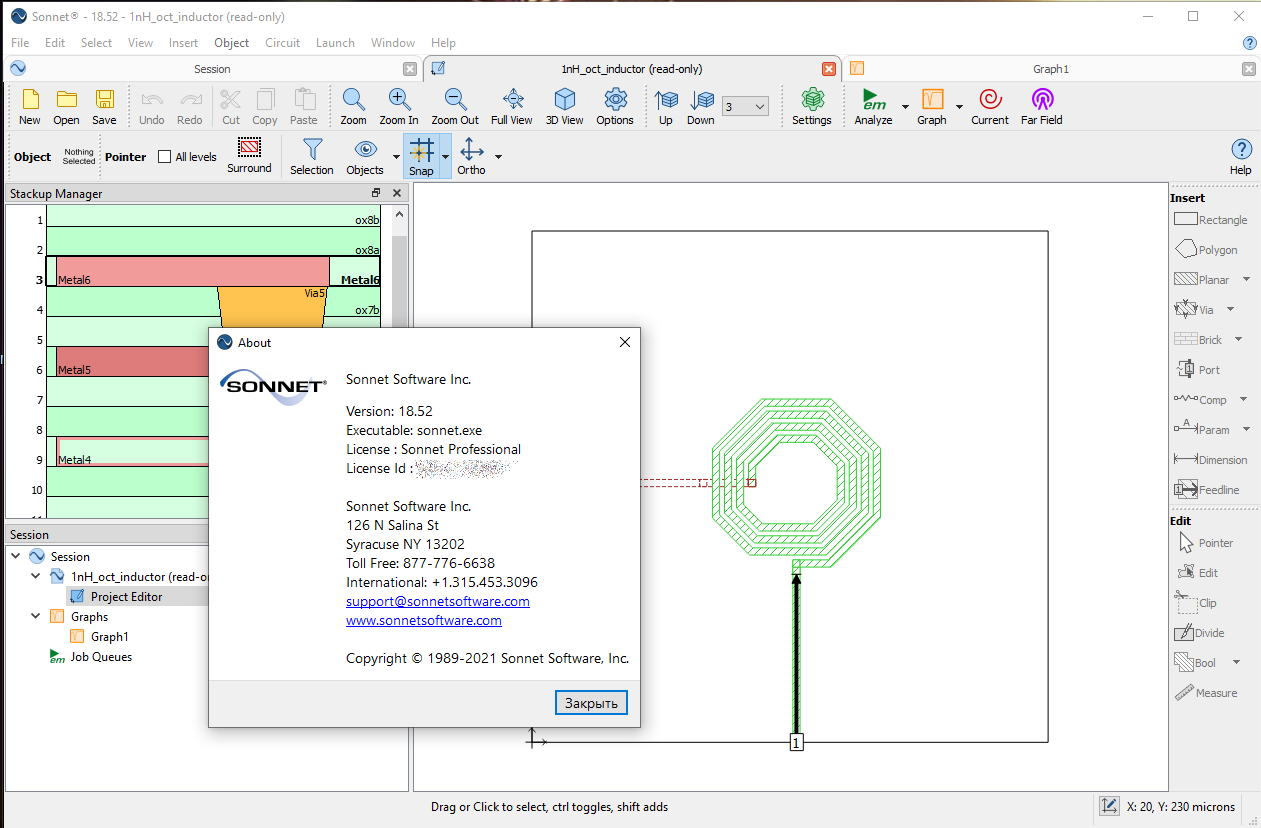Sonnet Suites 18.52 | 389.4 mb
The software developer Sonnet Software Inc. is pleased to announce the availability of Sonnet Suites 18.52. The new v18 builds upon the v17 revolution, adding ground breaking new technologies, enhancements, and robustness to the gold standard product from the world’s most tenured brand in EM simulation.
What's New in this Release
- The all-new TrueVolume metal model uses fully 3D subsections with volumetric currents to divide the volume of a thick metal model conductor into rectangular metal cubes, and then uses Sonnet's volume subsections to model those cubes, greatly reducing the need for large amounts of metal layers in many thick metal applications. This is a major introduction which blurs the lines between a 3D Planar and a 3D Arbitrary solver.
- The new Sonnet Technology File Editor, is a separate application bundled with the suite, and allows you to directly edit and create Sonnet Technology Files (.stf), which can be saved as templates, applied to projects, and more. Within the technology file editor, a Layer Mapping dialog enables you to map CAD layers and drawing purposes to Sonnet's tech layers. The layer mappings can now be saved to the Sonnet Technology File (.stf) files which now supports CAD Drawing Layers and purposes.
- The User Equation Editor allows you to define custom equations to be added as curves in a graph.
- You may now view 3D Antenna Pattern of your project.
- Sonnet now provides you with Graph and Pattern templates which contain settings of a graph, including color, format, port properties, frequencies, angles, or other settings used in your graph. The software provides a few common templates, but you may create your own templates to save them in a template folder for later use.
- Sonnet's ODB++translator now supports ODB++7.x and 8.x. databases.
- Sonnet has a redesigned home page giving you quick and easy access to your recently used projects and session.
- You may now plot more responses in the Current Density tab, including volume currents (in amps per square meter) and the current phase.
- You may now add Line Segment Markers to a graph or antenna pattern.
- When a list of sources becomes too long, you may now remove unused sources which are no longer in use with a simple command.
- The Sonnet Technology File (.stf) format now supports purposes.
13331 Enhance graphs to be able to save default startup curve and axis settings.
11682 The Project Editor won't allow diagonal reference planes for co-calibrated ports.
10704 Boolean subtraction on project with Dimension Parameters creates corrupt project.
12186 Sonnet graphs should use existing parameter combination of Cartesian plot when generating a smith chart.
12199 Sonnet graphs fail to create groups when a second project is added.
12307 GDSII translator imports a round number as non-rounded (e.g., 250 as 249.999).
12332 Sonnet Smith chart's add project should use/add the same curves as are existing.
12623 The Project Editor pastes objects outside viewable area when zoomed.
12677 The Project Editor saves absolute folder name instead of relative folder name for output file folder.
12894 After clicking a data point on a graph, the cursor moves when left or right arrow keys are pressed.
13300 Pattern Tab's Manage Curves needs an easier way to select multiple frequencies all at once.
13317 Em creates large aggregated via blocks within thick metal polygons when speed/memory set to middle setting.
13353 Using shift key in the Project Editor should toggle ortho mode.
13357 All files created by Sonnet on Windows include only the line-feed character at the end of each line.
13358 Emclient can delete netlist data at the end of a simulation.
13386 The Project Editor selections become super slow when there are many dimensions in the project.
13467 Em may terminate with error message when diagonal co-calibrated port is attached to thick metal polygon.
13474 Disconnect from VPN can kill a remote job.
13476 Top sheet of thick GLG metal may be displayed as standard metal in current density viewer and subsection viewer.
13478 ABS may not work well when simulation band is divided into multiple, intermingled sub-bands.
13480 The Project Editor's Move tool no longer auto-fills with the last measurement.
13493 Em simulates with de-embedding disabled whenever Local Analysis Options are enabled in the Project Editor.
13499 Em may terminate with internal error if circuit includes CPW vias to ground that are within 1 cell of a box wall.
13513 The Project Editor's table1 function corrupts the filename if using relative path.
13541 Meshing of rectangular group of co-calibrated ports may be incorrect.
13547 The Project Editor does not save both numbers for a ports-only component port that contains multiple numbers.
11694 Add right-click menu to jobs in queue tab.
11786 Project Editor's auto height vias don't work if via direction is upward.
12055 Job Queue icon in session panel is not updated.
3087 Project Editor ignores top and bottom metal when Rdc=Rrf=Xdc=0 and Ls > 0.
8333 Enhance Project Editor to show reference planes in different color when de-embedding is off.
10698 Em should provide more detailed information to user when it runs out of memory during a simulation.
12264 Curve markers may move when you zoom in and then zoom out to full view.
12449 Subsection viewer and current density viewer do not show ports on all levels of thick metal polygon.
12482 Project Editor's "Override Analysis Options" dbox is grayed out.
13349 Using Circuit Settings to delete layers can make bad vias.
13562 Job Queue may show incorrect status and frequency count information on simulations with pre-existing data.
13606 Some circuits require too much memory when using middle speed/memory setting.
13608 Add hover-over capability to curves panel and include parameter values.
13612 Saving files to network drives may give an error message.
13613 Modify Point Set of Anchored Dimension Parameter does not always work.
13614 Dimension parameters don't work properly if all coordinates of the two polygons have identical coordinates.
13626 soncmd -LoadTechnology should quit with an error message when tech file does not exist or can't be read.
13631 Changes in Box Cover - Metal properties do not trigger the need to save project.
13640 Remove conversion of Keysight ADS SLM substrate files to matl or stf files because it is no longer supported by Keysight.
13644 The "Lock toolbars and panels" setting is not remembered after restarting Sonnet.
13645 Add Project Editor preference to make Readout panel undockable.
13651 Em may generate corrupt results for parameter sweep with ABS frequencies followed by discrete frequencies.
13653 Em results show incorrect glitch for circuit simulated with TrueVolume.
13658 Importing (GDSII) to present project with linked technology file fails.
11682 The Project Editor won't allow diagonal reference planes for co-calibrated ports.
10704 Boolean subtraction on project with Dimension Parameters creates corrupt project.
12186 Sonnet graphs should use existing parameter combination of Cartesian plot when generating a smith chart.
12199 Sonnet graphs fail to create groups when a second project is added.
12307 GDSII translator imports a round number as non-rounded (e.g., 250 as 249.999).
12332 Sonnet Smith chart's add project should use/add the same curves as are existing.
12623 The Project Editor pastes objects outside viewable area when zoomed.
12677 The Project Editor saves absolute folder name instead of relative folder name for output file folder.
12894 After clicking a data point on a graph, the cursor moves when left or right arrow keys are pressed.
13300 Pattern Tab's Manage Curves needs an easier way to select multiple frequencies all at once.
13317 Em creates large aggregated via blocks within thick metal polygons when speed/memory set to middle setting.
13353 Using shift key in the Project Editor should toggle ortho mode.
13357 All files created by Sonnet on Windows include only the line-feed character at the end of each line.
13358 Emclient can delete netlist data at the end of a simulation.
13386 The Project Editor selections become super slow when there are many dimensions in the project.
13467 Em may terminate with error message when diagonal co-calibrated port is attached to thick metal polygon.
13474 Disconnect from VPN can kill a remote job.
13476 Top sheet of thick GLG metal may be displayed as standard metal in current density viewer and subsection viewer.
13478 ABS may not work well when simulation band is divided into multiple, intermingled sub-bands.
13480 The Project Editor's Move tool no longer auto-fills with the last measurement.
13493 Em simulates with de-embedding disabled whenever Local Analysis Options are enabled in the Project Editor.
13499 Em may terminate with internal error if circuit includes CPW vias to ground that are within 1 cell of a box wall.
13513 The Project Editor's table1 function corrupts the filename if using relative path.
13541 Meshing of rectangular group of co-calibrated ports may be incorrect.
13547 The Project Editor does not save both numbers for a ports-only component port that contains multiple numbers.
11694 Add right-click menu to jobs in queue tab.
11786 Project Editor's auto height vias don't work if via direction is upward.
12055 Job Queue icon in session panel is not updated.
3087 Project Editor ignores top and bottom metal when Rdc=Rrf=Xdc=0 and Ls > 0.
8333 Enhance Project Editor to show reference planes in different color when de-embedding is off.
10698 Em should provide more detailed information to user when it runs out of memory during a simulation.
12264 Curve markers may move when you zoom in and then zoom out to full view.
12449 Subsection viewer and current density viewer do not show ports on all levels of thick metal polygon.
12482 Project Editor's "Override Analysis Options" dbox is grayed out.
13349 Using Circuit Settings to delete layers can make bad vias.
13562 Job Queue may show incorrect status and frequency count information on simulations with pre-existing data.
13606 Some circuits require too much memory when using middle speed/memory setting.
13608 Add hover-over capability to curves panel and include parameter values.
13612 Saving files to network drives may give an error message.
13613 Modify Point Set of Anchored Dimension Parameter does not always work.
13614 Dimension parameters don't work properly if all coordinates of the two polygons have identical coordinates.
13626 soncmd -LoadTechnology should quit with an error message when tech file does not exist or can't be read.
13631 Changes in Box Cover - Metal properties do not trigger the need to save project.
13640 Remove conversion of Keysight ADS SLM substrate files to matl or stf files because it is no longer supported by Keysight.
13644 The "Lock toolbars and panels" setting is not remembered after restarting Sonnet.
13645 Add Project Editor preference to make Readout panel undockable.
13651 Em may generate corrupt results for parameter sweep with ABS frequencies followed by discrete frequencies.
13653 Em results show incorrect glitch for circuit simulated with TrueVolume.
13658 Importing (GDSII) to present project with linked technology file fails.
Sonnet's suites of high-frequency electromagnetic (EM) Software are aimed at today's demanding design challenges involving predominantly planar (3D planar) circuits and antennas. Predominantly planar circuits include microstrip, stripline, coplanar waveguide, PCB (single and multiple layers) and combinations with vias, vertical metal sheets (z-directed strips), and any number of layers of metal traces embedded in stratified dielectric material. The Sonnet Suites develop precise RF models (S-, Y-, Z-parameters or extracted SPICE model) for planar circuits and antennas. The software requires a physical description of your circuit (arbitrary layout and material properties for metal and dielectrics), and employs a rigorous Method-of-Moments EM analysis based on Maxwell's equations that includes all parasitic, cross-coupling, enclosure and package resonance effects. Sonnet maintains a single, dedicated focus on providing the industry's most accurate and reliable high frequency planar EM software. Our aim is to make it easy for our customers to either develop and analyze designs within our software, or to incorporate our tools into their existing design processes and frameworks. Customers need never commit to a proprietary framework in order to get the best in planar EM analysis.
Sonnet’s new v18 builds upon the v17 revolution, adding ground breaking new technologies, enhancements, and robustness to the gold standard product from the world’s most tenured brand in EM simulation.
Modeling Anisotropic Substrates
Did you know that permittivity is dependent on the direction of fields? This is called anisotropy, and not only does Sonnet support this in analysis, but we have developed a technique to characterize material as well. If you need accurate simulation, this tutorial is for you.
Founded in 1983 by Dr. James C. Rautio, Sonnet Software Inc. is a private company dedicated completely to the development of commercial high frequency EM software. We take great pride in providing quality technical support for our products–which we believe to be crucial for high-end technical software products. Sonnet Software, Inc. is based in Syracuse, NY, USA with representatives across the globe.
Product: Sonnet Suites
Version: 18.52 Professional
Supported Architectures: x64
Website Home Page : www.sonnetsoftware.com
Languages Supported: english
System Requirements: Windows *
Size: 389.4 mb
Please visit my blog
Added by 3% of the overall size of the archive of information for the restoration
No mirrors please
Added by 3% of the overall size of the archive of information for the restoration
No mirrors please











